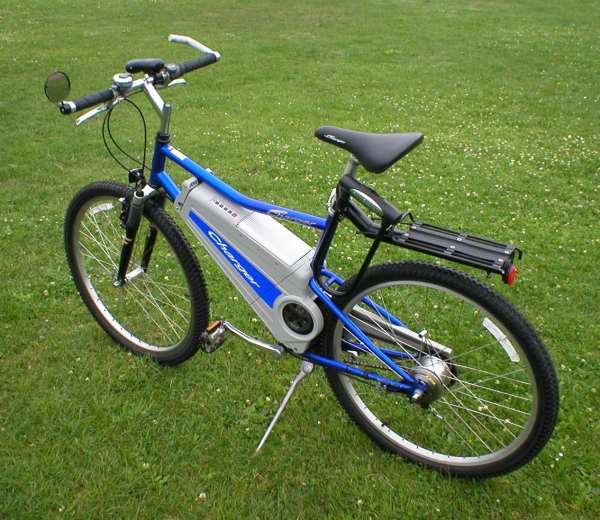|
|
|
|
|
|
|
|
|
|

the ultimate--yet affordable Bionic Bike! |
|
The legendary USA Made Charger bike is anxious to be your next set of wheels. After moving our warehouse we're shipping again!
At $1,050 (base model Standard or Comfort without shocks or extras like the mirror, carrier rack and lock shown in photo...) they're more affordable than ever! For an additional $200 you can replace the lead acid battery with the lithium iron phosphate option...in our view less volatile than the common lithium cobalt type. If in the future you wish to use the cheaper lead acid batteries, no problem, as the pack retains it's ability to charge these.
Pricing includes assembly if you pick up in San Francisco or at our Arbuckle shop 45 min. north of Sacramento. FREE SHIPPING with some out-of-carton assembly required for everyone else.
NOTE! Popular mid-drive kits now cost $750-1000 incl. battery and shipping! Now you can get the entire bike from us for about the same price!
Also, compare Chinese made mid-drives with torque sensor controller costing about twice as much...with inferior components and weaker frame. Ours is cro-moly, which is as light but stronger than aluminum. Ours has the internal gear rear hub!!
|
|
|
|
Now and then customers send us photos you might appreciate too!
This English policeman has appreciated the mid-drive, torque sensor motor controlled system running 375W (1/2 horsepower) through a 7 speed internal hub transmission. Like a car motor takes advantage of the increased torque in low gear and increased speed in higher gears, our bikes do the same.
Being the forerunner torque sensor mid-drive system produced, the Charger continues to be state-of-the-art! It also beats the competition due to the internal 7 speed gearing...normally not available on e-bikes.
|
|
|
|
|
|
|
|
|
Lithium Iron Phosphate batteries (otherwise referred to as LFP or LiFePO4), reduce the power pack weight by about 2/3, or the capacity can be increased and still weigh about half that of AGM (absorbed glass mat) sealed lead acid batteries still used for some customers.
In our research and experience the LFP batteries have proven to be less apt to catch fire. Unfortunately most "battery experts" don't point out this fact and claim a UL or CE stamp is what to look for. Knowing the Chinese vendors as we do, a stamp is not necessarily genuine.
We also prefer to use a minimum number of cells to reduce the likelihood that one causes havoc for the rest. This is not the case with most e-bike batteries which could have 2 to 4 times more cells than we use, and connected in series-parallel. The more cells, the more likely the BMS cannot fully protect from overcharging or over discharging, creating either a fire hazard and/or cell deterioration from becoming out of balance with the other cells.
Our packs include 8 cells when using the LFP. Lead acid batteries have 6 cells per 12V, so 12 cells in total. Though the current rage is to go lithium, lithium is actually more fragile and though claimed to have a greater charge-discharge cycle life, this may not always be the case if the battery management system for the pack fails over time. We therefore continue to recommend lead acid if the customer does not use the bike so frequently, is less capable of paying the premium, and does not need to remove and carry the battery any real distance. If the customer wishes to use lithium later, or if the lithium battery proves to not be necessary, the pack can be equipped with lead acid at any time in the future.
One final note... Tesla cars in the USA have used the cobalt-based lithium batteries, now made in Nevada. These are small cylindrical cells and amount to hundreds in each car to complete the required capacity. As you can imagine the battery management system (BMS) is quite complex to keep these small cells uniform and to not over-charge. Most Chinese EVs now use the LFP batteries, which are available in large 200Ah cell size. Tesla is using these in their China made cars as well. It stands to reason the BMS using fewer, larger cells is less complex. The phosphate-iron based chemistry has also proven to be less volatile and safer!
|
|
|

